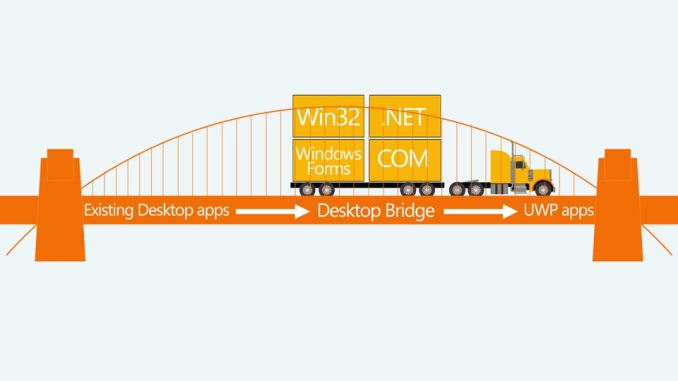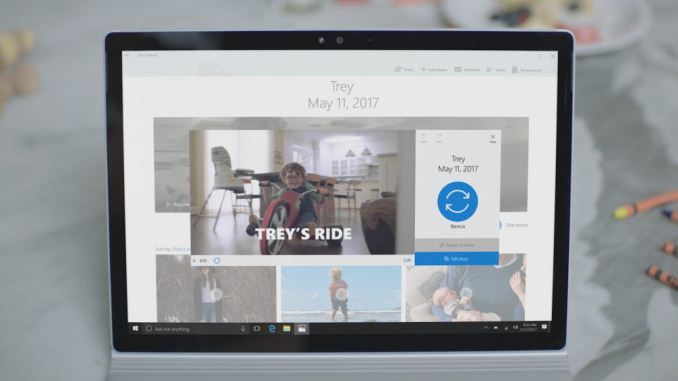The Microsoft Build 2017 Recap: What To Expect When You’re Expecting Windows
by Brett Howse on May 19, 2017 8:00 AM ESTWindows Store and UWP Updates
The Windows Store has never really gained the traction that Microsoft was hoping for, despite Windows 10 now on over 500 million devices. With Windows 10 S, which only allows Store installs (but can be upgraded to Windows 10 Pro for full app compatibility) Microsoft is hoping they can drive some more applications to the store. They’ve announced a lot of tools over the last couple of years to make it as easy as possible to get developers to move to the store, and there are significant advantages to both users and developers for having a system where they app is easily found, downloaded, and updated, but despite this it’s still been a challenge to drive developers to lock into UWP.
Part of that is that the sales pitch for UWP was to get apps to be available across different device types, and with the low usage share of Windows in the smartphone world, that was going to be a difficult sell. UWP needed to be aimed more at the desktop earlier, but regardless, a developer could target all of the Windows install base of over 1 billion machines by building a Win32 app, or just target Windows 10 installs with a UWP store app.
Possibly the biggest saving grace for Microsoft’s Store efforts got announced at Build last year, with Project Centennial, which was later branded the Desktop App Converter. This simple tool allows most apps to be quickly repackaged into a Store app, with few, or no, changes required to the app. This doesn’t make it a UWP app of course, but it does allow it to be put in the Store, updated through the Store, and includes the sandboxed security model of Store apps. It’s been a nice addition to the Windows arsenal, and Microsoft had seen some great desktop apps like Adobe Photoshop Elements come to the Store through this bridge.
At Build, Microsoft announced some other big apps coming through the Desktop Bridge. iTunes is coming to the Windows Store, which is kind of amazing when you think about it. The best part for Windows users who do use iTunes is that the app can’t do anything to your system, and if you install it, it’s all gone with none of the normal remnants lingering throughout the file system and registry. Autodesk is also bringing Stingray to the store, and SAP Digital Boardroom is also on its way. SAP is a big player in business, so for Microsoft to get Windows 10 S into the enterprise, these types of apps need to make their way into the store.
UWP also got some love at the conference, so even though the Desktop Bridge is going to be the carrot to get apps into the store, UWP needs to continue to improve in order to tempt developers to leverage its advantages. .NET Standard 2.0 for UWP was announced at Build, and XAML Standard will be available later on this year to help with cross-platform capabilities. With Microsoft’s purchase of Xamarin, it makes a lot of sense for them to try and leverage that purchase into further expanding UWP. .NET Standard is adding more than 20,0000 APIs to UWP, including the most requested APIs such as Reflection and SqlClient are coming with the Fall Creators Update.
The Store needs to continue to improve, and it does appear that Microsoft is getting some buy-in with some bigger companies, which is important. The Desktop Bridge for Windows continues to be a strong tool to remove some of the barriers to bringing an existing app into the new world without having to re-write the app from the ground up. It’ll be interesting to see how they progress between now and the Fall Creators Update.












85 Comments
View All Comments
Kevin G - Tuesday, May 23, 2017 - link
Not sure that is true anymore (it certainly was in the past). This have changed with 10 bit and HDR becoming consumer technologies now.CSMR - Saturday, May 20, 2017 - link
"Windows has never had a color management system to speak of"The current color management system dates back to Windows Vista and Microsoft imaging applications did a good job, with some exceptions including Internet Explorer/Edge. Win10 even does a reasonable job by default, with default monitor profiles loaded automatically.
Brett Howse - Saturday, May 20, 2017 - link
It's hard to give Windows credit for color management when all of the burden is put on the developer to do all the work. That's the case right now with wide color and HDR too but doesn't appear to be the long term goal.ironwing - Sunday, May 21, 2017 - link
"Possibly some of the biggest news about Windows actually got announced on April 20, when Microsoft committed to biannual updates for their operating system."Should be "semiannual".
Brett Howse - Sunday, May 21, 2017 - link
Definition of semi-annual: occurring every six months or twice a year
Definition of biannual
: occurring twice a year
ironwing - Sunday, May 21, 2017 - link
Oops, I was reading biennial. My bad, carry on.sorten - Sunday, May 21, 2017 - link
When I saw the Google IO live coverage I was wondering if you were going to mention Build from the previous week.zepi - Monday, May 22, 2017 - link
I think one remaining issue with using Windows is the complexity of licensing in business use. Buying individual license for personal usage is simple enough, but licensing models for server versions are still a dark art.If I were a manager making decision on whether we should use Windows or Linux as a OS under our application platform, I'd be worried that costs are very opaque and I have hard time understanding the licensing. Now, obviously one doesn't just do a decision like that and .net being open sourced and usable on linux these caveats have reduced somewhat, but the underlying issue is still there.
I suppose MS thinks that azure solves this by providing a simple monthly rolling cost that abstracts everything into a one monthly bill...
doggface - Monday, May 22, 2017 - link
You are forgetting enterprise.The thing windows does very well is scale. For example, If you want to deploy an app to 5000 PCs you can click a few buttons and it is done.
If you want to block behaviour, you can do it using GPOs.
No other platform has that control.
doggface - Monday, May 22, 2017 - link
I think we can all agree you have control issues.